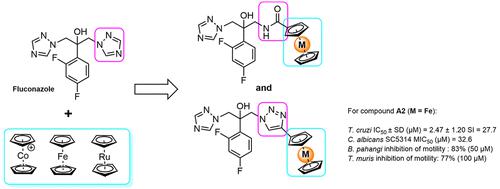当前位置:
X-MOL 学术
›
ACS Infect. Dis.
›
论文详情
Our official English website, www.x-mol.net, welcomes your feedback! (Note: you will need to create a separate account there.)
Antifungal and Antiparasitic Activities of Metallocene-Containing Fluconazole Derivatives
ACS Infectious Diseases ( IF 5.3 ) Pub Date : 2024-02-08 , DOI: 10.1021/acsinfecdis.3c00577 Yan Lin 1 , Gonzalo Scalese 2 , Christina A. Bulman 3 , Robin Vinck 1 , Olivier Blacque 4 , Margot Paulino 5 , Andres Ballesteros-Casallas 5 , Leticia Pérez Díaz 6 , Gustavo Salinas 7, 8 , Makedonka Mitreva 9 , Tobias Weil 10 , Kevin Cariou 1 , Judy A. Sakanari 3 , Dinorah Gambino 2 , Gilles Gasser 1
ACS Infectious Diseases ( IF 5.3 ) Pub Date : 2024-02-08 , DOI: 10.1021/acsinfecdis.3c00577 Yan Lin 1 , Gonzalo Scalese 2 , Christina A. Bulman 3 , Robin Vinck 1 , Olivier Blacque 4 , Margot Paulino 5 , Andres Ballesteros-Casallas 5 , Leticia Pérez Díaz 6 , Gustavo Salinas 7, 8 , Makedonka Mitreva 9 , Tobias Weil 10 , Kevin Cariou 1 , Judy A. Sakanari 3 , Dinorah Gambino 2 , Gilles Gasser 1
Affiliation

|
The search for new anti-infectives based on metal complexes is gaining momentum. Among the different options taken by researchers, the one involving the use of organometallic complexes is probably the most successful one with a compound, namely, ferroquine, already in clinical trials against malaria. In this study, we describe the preparation and in-depth characterization of 10 new (organometallic) derivatives of the approved antifungal drug fluconazole. Our rationale is that the sterol 14α-demethylase is an enzyme part of the ergosterol biosynthesis route in Trypanosoma and is similar to the one in pathogenic fungi. To demonstrate our postulate, docking experiments to assess the binding of our compounds with the enzyme were also performed. Our compounds were then tested on a range of fungal strains and parasitic organisms, including the protozoan parasite Trypanosoma cruzi (T. cruzi) responsible for Chagas disease, an endemic disease in Latin America that ranks among some of the most prevalent parasitic diseases worldwide. Of high interest, the two most potent compounds of the study on T. cruzi that contain a ferrocene or cobaltocenium were found to be harmless for an invertebrate animal model, namely, Caenorhabditis elegans (C. elegans), without affecting motility, viability, or development.
中文翻译:

含茂金属氟康唑衍生物的抗真菌和抗寄生虫活性
寻找基于金属络合物的新型抗感染药物的势头正在增强。在研究人员采取的不同选择中,涉及使用有机金属配合物的方案可能是最成功的方案,该方案使用了一种化合物,即二茂铁喹,该化合物已在针对疟疾的临床试验中。在这项研究中,我们描述了已批准的抗真菌药物氟康唑的 10 种新(有机金属)衍生物的制备和深入表征。我们的理由是,甾醇14α-去甲基酶是锥虫中麦角甾醇生物合成途径的酶的一部分,与病原真菌中的酶相似。为了证明我们的假设,还进行了对接实验来评估我们的化合物与酶的结合。然后我们的化合物在一系列真菌菌株和寄生生物上进行了测试,包括导致恰加斯病的原生动物寄生虫克氏锥虫(T. cruzi),恰加斯病是拉丁美洲的一种地方性疾病,属于全球最流行的寄生虫病之一。令人高度感兴趣的是,在克氏锥虫研究中发现两种最有效的化合物,其中含有二茂铁或二茂钴,对无脊椎动物模型即秀丽隐杆线虫(C. elegans )无害,不会影响运动性、生存力或发展。
更新日期:2024-02-08
中文翻译:

含茂金属氟康唑衍生物的抗真菌和抗寄生虫活性
寻找基于金属络合物的新型抗感染药物的势头正在增强。在研究人员采取的不同选择中,涉及使用有机金属配合物的方案可能是最成功的方案,该方案使用了一种化合物,即二茂铁喹,该化合物已在针对疟疾的临床试验中。在这项研究中,我们描述了已批准的抗真菌药物氟康唑的 10 种新(有机金属)衍生物的制备和深入表征。我们的理由是,甾醇14α-去甲基酶是锥虫中麦角甾醇生物合成途径的酶的一部分,与病原真菌中的酶相似。为了证明我们的假设,还进行了对接实验来评估我们的化合物与酶的结合。然后我们的化合物在一系列真菌菌株和寄生生物上进行了测试,包括导致恰加斯病的原生动物寄生虫克氏锥虫(T. cruzi),恰加斯病是拉丁美洲的一种地方性疾病,属于全球最流行的寄生虫病之一。令人高度感兴趣的是,在克氏锥虫研究中发现两种最有效的化合物,其中含有二茂铁或二茂钴,对无脊椎动物模型即秀丽隐杆线虫(C. elegans )无害,不会影响运动性、生存力或发展。



























 京公网安备 11010802027423号
京公网安备 11010802027423号